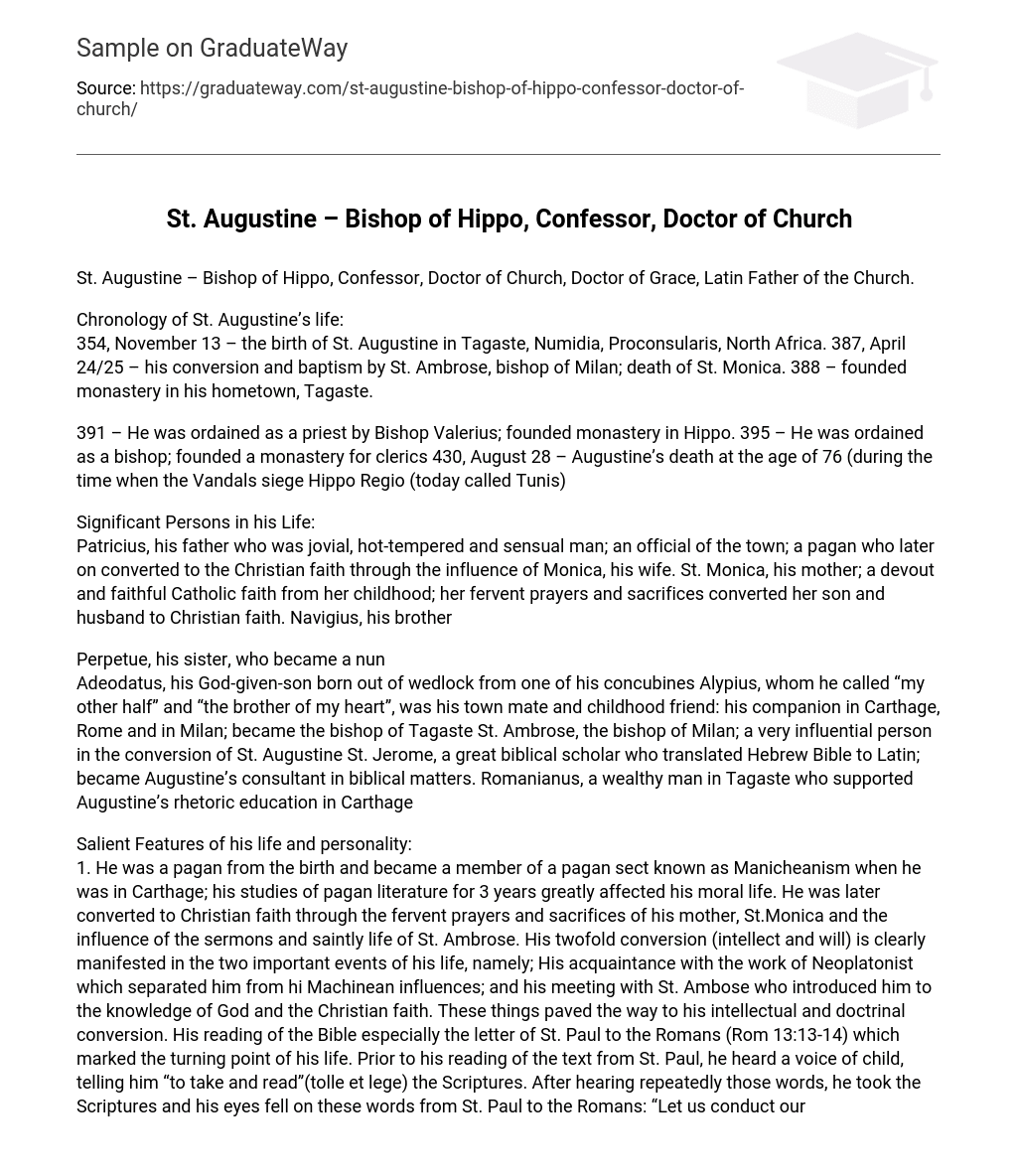Chronology of St. Augustine’s life
- 354, November 13 – the birth of St. Augustine in Tagaste, Numidia, Proconsularis, North Africa.
- 387, April 24/25 – his conversion and baptism by St. Ambrose, bishop of Milan; death of St. Monica.
- 388 – founded monastery in his hometown, Tagaste.
- 391 – He was ordained as a priest by Bishop Valerius; founded monastery in Hippo.
- 395 – He was ordained as a bishop; founded a monastery for clerics 430,
- August 28 – Augustine’s death at the age of 76 (during the time when the Vandals siege Hippo Regio (today called Tunis)
Salient Features of his life and personality
He was a pagan from the birth and became a member of a pagan sect known as Manicheanism when he was in Carthage; his studies of pagan literature for 3 years greatly affected his moral life. He was later converted to Christian faith through the fervent prayers and sacrifices of his mother, St.Monica and the influence of the sermons and saintly life of St. Ambrose. His twofold conversion (intellect and will) is clearly manifested in the two important events of his life, namely; His acquaintance with the work of Neoplatonist which separated him from hi Machinean influences; and his meeting with St. Ambose who introduced him to the knowledge of God and the Christian faith.
These things paved the way to his intellectual and doctrinal conversion. His reading of the Bible especially the letter of St. Paul to the Romans (Rom 13:13-14) which marked the turning point of his life. Prior to his reading of the text from St. Paul, he heard a voice of child, telling him “to take and read”(tolle et lege) the Scriptures.
After hearing repeatedly those words, he took the Scriptures and his eyes fell on these words from St. Paul to the Romans: “Let us conduct ourselves properly as in the day, not in the orgies and drunkenness, not in promiscuity and licentiousness, not in rivalry and jealousy. But on the lord Jesus Christ, and make no provisions of the desires of the flesh”. After reading these words, Augustine strongly felt God’s grace that inspired and strengthened to renew his life once and for all. (Confessions, Book VIII. Ch, 12).
After this gracious moment, he retreated to a villa in Cassiciacum with some of his relatives and friends to discuss among themselves matters concerning the TRUTH and “what constitutes a happy life.” After months of prayer and reflection, Augustine, Adeodatus and Alypius registered their names at the Cathedral of Milan as candidates for baptism. On Easter Sunday, April 24/25, 387, Bishop Ambrose baptized Augustine and his companions.
He was a courageous defender of faith and spiritual leader. He defended the Church against paganism and heresies propagated the following: Manicheanism, founded by Mane who claimed that there are two ultimate sources of creation, the one good and the other evil. According to this belief, man’s spirit is from God; his body is from the devil. Pelagianism, founded by Pelagius who claimed that man’s freewill to do good is enough to achieve salvation without the grace of God. Donatism, founded by Donatus who taught that the validity of the sacraments depends on the worthiness of the minister.
He was a FOUNDER of monastic and religious communities of men and women who devoted their lives in search for truth through prayer and community life. In 388, Augustine founded a monastery in his hometown, Tagaste. In 349-430, the Augustinian monastic life was propagated in Africa through the friends and disciples of St. Augustine.
In 1256, the small and scattered hermitages following the rule of St. Augustine were united by the Holy See as one legal canonical order known as the Hermit of St. Augustine (OHSA). This Great Union was confirmed in the Papal Bull Licet Ecclesiae Catholicae by Pope Alexander IV. It was later renamed as the Order of St. Augustine (OSA) where the Order of the Augustinian Recollects (OAR) originated.





